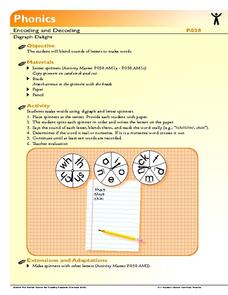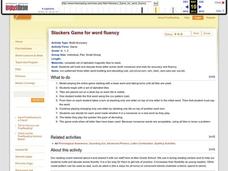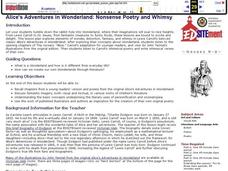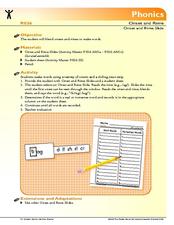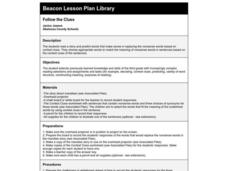Curated OER
Edward Lear, Limericks, and Nonsense
Introduce your class to the delights of nonsense poetry and explore literary devices with the writing of Edward Lear. Learners identify rhyme and meter as well as figures of speech, alliteration, and onomatopoeia in "The Owl and the...
Curated OER
Edward Lear, Limericks, and Nonsense: There Once Was...
Students recognize poetic devices including rhyme, syllabification, and meter. They identify the characteristics of a nonsense poem and of a limerick. They write their own limericks.
Houston Teachers Institute
Alice in Wonderland: Nonsense and Logic in Literature
Alice's Adventures in Wonderland is known for its fantastical imagery and nonsense verse. This unit plan offers a basic exploration into nonsense verse through poetry and teacher read-alouds. It incorporates activities involving poetry...
Curated OER
Nonsense Dictionary
Third graders explore various media. They identify the characteristics of various sources and use that material effectively. Students identify the characteristics of Dr. Seuss' work and the characteristics of a dictionary. They create a...
Curated OER
Recognize Nonsense Words
In this nonsense worksheet, learners read six sentences and replace the blue nonsense word with a better word from two choices. Students write the more logical word on the line.
Curated OER
Absurdities: Nonsense Words Don't Fit
In this absurdities worksheet, students read 6 illustrated sentences and analyze the nonsense word in blue. Students replace the word with the best choice from 2 choices.
Curated OER
Edward Lear, Limericks, and Nonsense: There Once Was?
Students explore limericks. In this poetry writing lesson, students listen to and read a variety of poems written by Edward Lear. Students count syllables and identify meter by clapping as they read aloud. Students complete a limerick...
Florida Center for Reading Research
Phonics: Encoding and Decoding, Three-In-One
Scholars use the provided pack of alphabet cards to construct basic CVC words, then write down each word they make in one of two columns. Column one is for real words and column two is for nonsense words.
Florida Center for Reading Research
Phonics: Encoding and Decoding, Digraph Delight
There are three spinners to use in this phonic activity. Spinner one contains digraphs, spinner two contains vowels, and spinner three contains consonants. Learners spin each spinner, write down the letters they get, blend them to make a...
K12 Reader
Jabberwocky
Readers demonstrate their ability to use word endings and word relationships to identify the parts of speech of the nonsense words in Lewis Carroll's "Jabberwocky."
Curated OER
Stackers Game for Word Fluency
Explore words by building and decoding three-letter words. Real or nonsense words can be formed with the alphabet tiles. Practice fluency and blending sounds with CVC patterns.
Curated OER
"Jabberwocky": Inferring
Pupils, over an extended time, read and explain the nonsense words of Lewis Carroll's poem, "Jabberwocky". They infer the meaning of the poem using visualizing as well as decoding skills. While written for first graders, this is easily...
Curated OER
Alice's Adventures in Wonderland: Nonsense Poetry and Whimsy
Primary learners are introduced to Lewis Carroll's whimsical poetry. They read "The Nursery Alice" Carroll's adaptation for younger readers, view story illustrations, listen to poetry and write whimsical verses of their own about food.
Curated OER
Nonsense Knows
For this poetry lesson, young readers discuss that poems can sometimes have silly words and made up people, places, and things. Students read and listen to silly poems then write a response poem to their favorite.
Heidi Songs
Ladybug Color Nonsense
Let these ladybugs teach your youngsters a thing or two about spelling CVC words. Kids color the real words black and the fake words red to reveal what these ladybugs really look like.
Florida Center for Reading Research
Onset and Rime Slide
Discover onset and rime blends using this interactive activity which will appeal to your kinesthetic learners. Using the sliding templates provided, budding readers try different onsets with each rime. They practice reading skills by...
Curated OER
Different Types of Poetry
Provide pupils samples of different types of poems including haikus, narrative, nonsense, shape, and rhyming poems. In groups, class members read the poems, establish their general meaning, identify poetic devices, and rate the poems,...
Florida Center for Reading Research
Phonics: Encoding and Decoding, Letter Cube Blending
Emergent readers use a letter cube to identify, blend, and make words. They roll each of the three-letter cubes, mark down the letters they rolled, then blend the letter sounds together to make a word. They record each word on a...
Florida Center for Reading Research
Phonics: Onset and Rime, Word Swat
With a fly swatter in hand, learners swat the rime-flys with their onset swatter to make, read, and write words by blending the onset with the rime-fly. Scholars blend words, make and write words, and also work to determine if the words...
Curated OER
Follow the Clues
Students read a story and predict words that make sense in replacing the nonsense words based on context clues. Students choose appropriate words that will match the meanings of the nonsense words.
Curated OER
Test Your Patience: Nonsense Quiz
In this testing patience worksheet, students read through the quiz that doesn't make sense. Students then try to answer the 20 questions to taste their patience.
Curated OER
Learning to Multiply
Learning how to multiply is the focus of this math resource. The first of five pages reviews the multiplication process as repeated addition. The second provides a few examples that you might consider working through with the class. An...
Curated OER
Using Context Clues
Teach your third graders how to find the meanings of words using context clues. Using this reading lesson, discuss how readers can find the meaning of a word by using the sentences around it. They then complete a worksheet in which they...
Bright Hub Education
Jabberwocky - A Creative Writing Lesson Plan
Make some sense out of Lewis Carroll's famous nonsense poem "Jabberwocky." After reading through the poem, introduce the word portmanteau and send small groups off to alter the original poem.
Other popular searches
- Nonsense Words
- Nonsense Words List
- Context Clues Nonsense Words
- Nonsense Poems
- Phonics Nonsense Words
- Nonsense Words Kindergarten
- Nonsense Word Fluency
- Nonsense Words Cards
- Cvc Nonsense Words
- Nonsense Poetry
- Nonsense Rules
- Edward Lear Nonsense Poems










